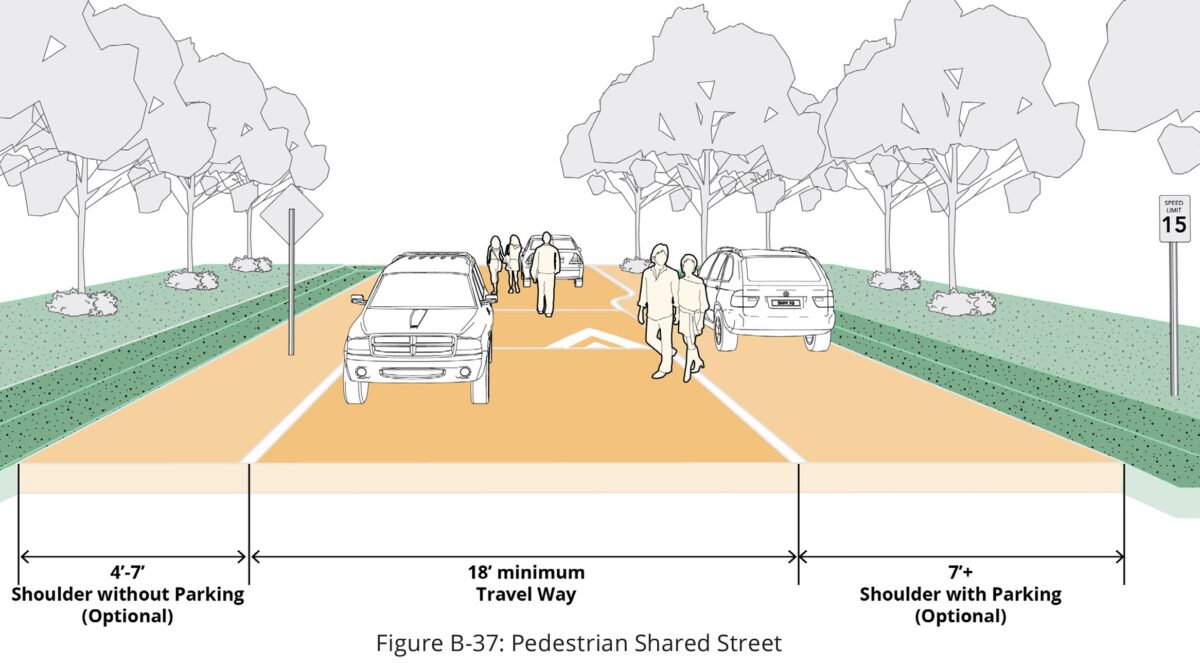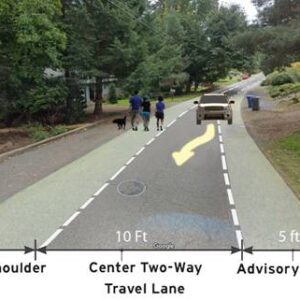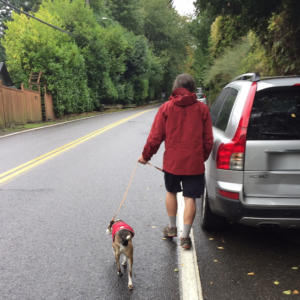
Last week, the Portland Bureau of Transportation (PBOT) posted its revisions to the draft Pedestrian Design Guide (PDG) which it had released for public comment in September. The new version updates the City’s 1998 PDG and is the City’s primary guidance on how sidewalks should be built throughout Portland.
Pedestrian Coordinator Michelle Marx noted in an email to stakeholders and interested parties that “the Guide underwent a robust 30-day public review period in Fall 2021 and was revised and updated in response to public comment.” A comparison between September’s original draft and the current updates shows that the PDG team did indeed make significant clarifications and changes, particularly concerning Narrow Residential Roadways (NRR), which have been a recent focus of several advocates.
Advertisement

BikePortland readers may recall Michael Reiss from our article last year about his DIY traffic-calming endeavors. He is the man who was “ready to grab some neighbors, a bucket of paint” and paint advisory shoulders on SW 18th Place. Like so many BikePortland articles, we closed with “Stay tuned.” Well, last week Reiss contacted BikePortland to update us on how things had progressed since we last spoke, and how the PDG update might help with his traffic-calming project:
I had conversations with PBOT staffers, and I was able to get a better understanding of what the various engineering/political/liability roadblocks were. In my opinion it all really came down to how the definition of the Oregon statute regarding “narrow residential roadways,” and the 18 ft width limit, was interpreted. The important questions were:
-Does the presence of on-street parking reduce the official travel way width?
-Can streets with pavement width greater than 18ft qualify?
-Can edge lines be added to reduce the official travel way width?
(A Narrow Residential Roadway is defined in Oregon law (ORS 801.368) as a two-way residential street which is not wider than 18 ft “measured exclusive of shoulders and/or on-street parking”. The speed limit on these narrow streets is, also by statute, 15 mph, thus the designation confers a speed limit reduction from the standard 20 mph.)
Reiss submitted a detailed comment to PBOT requesting that the use of fog lines be allowed to narrow travel ways to 18 ft thus converting technically non-conforming streets into NRR’s. He wrote to tell us that the revised PDG seems to have taken his suggestion, “an edge-lane design is now officially available to PBOT engineers!” The new language in the PDG reads:
The width ordinarily used for vehicle travel can be narrowed to 18 feet or less with painted line(s), wands, planters, and other furniture as appropriate,
Implementation is still firmly in the hands of PBOT planners and Reiss can’t just grab a bucket of paint, some neighbors, and paint fog lines on his street. But the planners Reiss is lobbying now have an important new traffic-calming tool available to them, one which is particularly relevant to southwest and east Portland, two areas of town with narrow streets which often lack sidewalks.
The new language seems like a win for Portland and a wonderful example of the bureau listening to — and using! — comments from the community to arrive at better outcomes.
In addition to his conversations with PBOT staff, Reiss also discussed the issues with Portland attorney (and BikePortland supporter) Scott Kocher. Kocher has been advocating for reduced speed limits for several years. Concerning NNRs, he told BikePortland last year, “I think there’s a huge opportunity here…Even if the pavement on your street is wider than 18 feet, it can be striped with a fog line, or furnished with planters, benches, etc. that limit the ‘used for vehicular travel’ portion to 18 feet.” He also pointed out that what is known as our local “20 mph” ordinance actually requires the city to reduce speed limits by 5 mph below the statutory limit in residence districts. When that local ordinance is applied to the statutory 15 mph of NRRs “it means that we can achieve 10 mph on many more streets at low cost.”
We will have to wait to see how widely PBOT implements the NRR clarifications in the PDG, but for now the new language seems like a win for Reiss and Kocher, a win for Portland, and a wonderful example of the bureau listening to — and using! — comments from the community to arrive at better outcomes.






Thanks for reading.
BikePortland has served this community with independent community journalism since 2005. We rely on subscriptions from readers like you to survive. Your financial support is vital in keeping this valuable resource alive and well.
Please subscribe today to strengthen and expand our work.
Sorry, to say this over and over, but without enforcement no amount of street “calming” or reductions in speed limits will be a deterrent to drivers and magically make our streets safer. I can only speak about my neighborhood of course, which I routinely walk through and have cars routinely speed through. Once upon a time it was rare to see someone blow through a stop sign, but now it’s normal behavior.
People know there’s no enforcement, so they’ll just ignore the laws that they find inconvenient. Heck there’s even cyclists in these forums that advocate for ignoring laws that cause them a minor inconvenience. So, with that attitude is it any surprise drivers feel the same?
As noted, this pattern, which allows parking on both sides, and relies on people walking down the middle, hemmed in by parked cars on each side, can be dangerous with a careless driver, even if they’re going 15 mph. The visually impaired are especially in danger. We already have 20 mph limits on most residential streets, and look how fast people drive. dropping from “20” to “15” won’t make much different as long as there’s a clear path for cars to speed through.
Hi Solar and Doug (below),
I came back from three months in Paris a true believer in the Engineering “E” of the three “E”s–Engineering, Enforcement and Education. And also with a re-enforced appreciation that 30 years of de-regulation away from pedestrian safety in the design of our cars has made it very, very difficult to engineer road design that can protect against the typical American vehicle.
On my way home I took the red line from PDX to Goose Hollow, and was not three steps onto Portland terre firma when an SUV driver made a wild left turn onto Jefferson, over-corrected, came careening toward me and then managed to get his SUV under control. Welcome back home!
The raised pedestrian island built for the MAX would not have protected against this driver in this SUV. PBOT has a close to impossible task protecting us against the enormous SUVs/trucks most people choose to drive.
Does that mean every safety improvement should be met with a chorus of “not good enough” and “more police?” I don’t think so. In the spirit of not letting the perfect be the enemy of the good, I’ll make a couple points:
1) Engineering rubrics consider posted speed when determining what traffic calming measures are allowed. A speed limit lowered to 15 (or 10) mph permits more robust traffic-calming infrastructure to be used.
2) Regarding ADA, look at Michael Reiss’s design at the top of the article. The present situation, on left, is not safe. The white line re-designates the street class so that it can be made safer. The new PDG text mentions “planters, and other furniture,” which opens the door for chicanes and other protections. Most of SW Portland’s streets are similar to Reiss’s photo-we don’t have sidewalks and people (maybe even blind people) walk in the street together with moving cars. That is the status quo. PBOT planners retain firm control on where this treatment is appropriate.
I also think that it’s crucial that we better align our vehicle purchasing incentives with climate and transportation equality goals. The gas guzzler tax hasn’t been substantially amended since its inception in the late ’70’s, and doesn’t even apply to the SUVs, crossovers, and pickups that make up almost 80% of all vehicles sold today! It also has no penalty for vehicles that average more than 22.5mpg on the EPA cycle. This is a serious problem, as it will also have no bearing on EVs, despite the risk their massive weight bears for other people on the roadway. The tax should be switched to a combination of fuel consumption and vehicle weight. We need to discourage people buying what the automotive industry tells them they need: large vehicles that are a hazard to others and (even after they electrify) do damage to the environment in excess to any benefit they produce for the people who buy them.
Sorry to say this over and over, but Portland’s data show speed limit signs reduce top-end speeding significantly, at the current enforcement levels.
The BikePortland story on it from December 2020.
It’s not a fix-all, but it does change behavior.
Not really. There is currently no enforcement. The “before” speeds cited in the study were from 2018; the “after” speeds were from 2019 when there actually was some enforcement. It’s the wild west out there.
If even half of all motor vehicle drivers respect posted speeds that limits the ability of scofflaws to act out. This is a message problem, a cultural problem. There are not enough police officers to watch my street or yours.
“Not really.” Data please.
I was responding to Evan’s claim that high speeds were reduced “at current enforcement levels.” He was citing a study using 3 and 4 year old data. Current enforcement is not what it was 3 and 4 years ago.
Maybe this will work in some places, but I sure wouldn’t call it a “pedestrian facility”. I’m surprised PBOT thinks this would pass an ADA lawsuit, since it’s being touted as such, and obvious won’t work for the visually impaired.
I’m interested in the legal standings of pedestrians in the roadway. When we did our greenway markings project last spring, we had approached a PBOT project manager about the legality of labelling the roadway for pedestrian use. We had thought that greenways meant vehicles must yield to pedestrians given the signage. But they told us there’s still no legal right to use the roadway as a pedestrian without having to yield to vehicles, even on greenways and all the added signage during the pandemic. Pedestrians must always yield, and should use separate pedestrian facilities if provided.
I just feel like this goes against the images the signs show and even how pedestrians are using the middle of the roadway on THE COVER of the 2020 Neighborhood Greenways Report.
Pedestrians must always yield to vehicles in the roadway (ORS 814.040), and there’s still no exceptions to this as far as I’ve heard (is there a lawyer in the room?). And as Doug brings up in his comments: this might pose some consequence if its also designed as the ADA pedestrian facility for the right of way.
Hi Nic,
I’m not nuts about the PBOT graphic, and I think it might also have an error. I think the roadway should be labeled as 18′ MAXIMUM, not minimum.
Yeah that graphic is very wrong for a number of reasons. I just forwarded these concerns to PBOT, hopefully they will fix/replace it:
It specifies 18’ minimum Travel Way – that should be maximum.
The people walking in the middle of the road and the default driving position on one side (rather than middle when there are no on-coming vehicles) doesn’t exemplify how the street is supposed to work (see ruraldesignguide.com/mixed-traffic/yield-roadway for a better example).
The 32’ total pavement width is not representative of many situations in Portland.
My neighbors can’t seem to keep from driving on our residential neighborhood streets at less than 25 mph now. For that matter, most roll through stop signs a 5 to 10 mph.
How many hundred thousand dollars will PBOT spend on posting new 15 mph signs? On the other hand, PBOT could hire some new staff, establish a task force, do a study, and make presentations at far away conferences about how successful it is. So, it won’t be a total loss.
Yeah, the key to that is to narrowing the vehicle lane enough so that drivers shift their collision avoidance behavior from “stationary object in MY lane” to “oncoming vehicular traffic in the narrow center lane”. It is amazing how quickly the estimation of ‘safe speed’ changes when you don’t have the expectation of an empty lane in front of you (especially on a curvy road). I have been driving down the middle of the road in neighborhood almost 2 years now (I have noticed more than a few others doing the same as well). It makes a huge difference. If lines and some signage convince most of those who still think they are supposed be driving on one side of the street to follow the shared street guidance, enforcement would be much less of an issue.
Let’s not forget the upcoming PSU study(s) and the new page in the NACTO design guide.
Love this! A creative and cheap solution. Looking forward to seeing it implemented in SW and beyond!
Won’t drivers go faster if there’s painted lines? I thought this was the case when two lane streets with painted lines were compared to streets with no lines.
I think this was the case for centerlines, which sends a subtle signal like “this is a highway.” IDK about foglines, edge striping, whatever this is
mr weiss is good hearted, but i’m not convinced of his proposed scheme
sw 18th place has drivers routinely drive over the existing centerlines to cut the turns and maintain higher speeds. as a driver here, i can state almost-head-ons are more frequent than one might expect/desire.
i am cynical that a striping action will change these behaviors, esp with an unusual system drivers have never encountered before.
and i am worried that roadway parking to access the trailhead for marshal park (which is on one of these curves) will endanger pedestrians further as they pop out between vehicles into a smaller road.